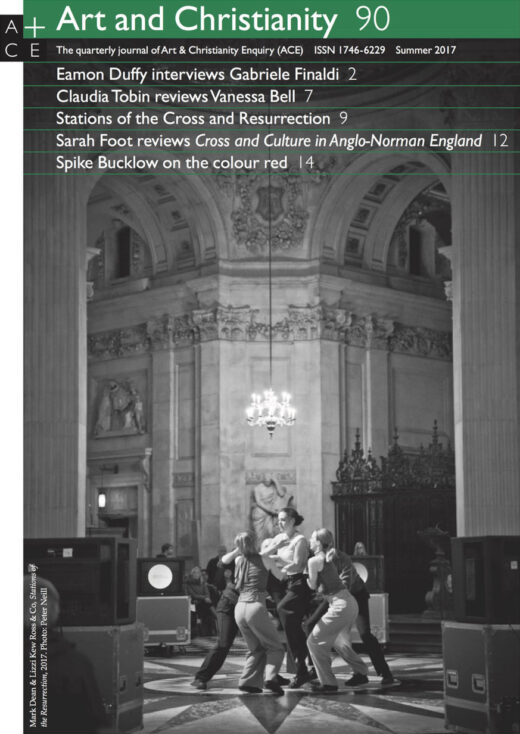Stations of the Resurrection

St Paul’s Cathedral, London
26 April 2017
12 monitor video and sound installation, with dance by Lizzi Kew Ross & Co →
feat. Morrighan MacGillivray, Henry Montes, Sonia Rafferty, Alice Sara, David Waring.
Costume design: Suzie Holmes
curated by Lucy Newman Cleeve
installation view
bibliography:
Stations of the Cross | Stations of the Resurrection, Stations 2017, catalogue, ISBN 978-1-5272-0874-2s
Lucy Newman Cleeve, ‘From Station to Station – In the Order of Signs’, catalogue essay
Laura Moffatt, ‘Stations of the Cross and Resurrection’, Art & Christianity, No 90, Summer 2017
Muriel Zagha, ‘From Psycho to Transcendence’, Elephant, 2017
exhibited works:
Laura Moffat, Art and Christianity 90, Summer 2017 →
There are many priests for whom a creative practice has been or is a part of their ministry, and successfully too. None more so than Mark Dean (see interview in A&C67), whose career as an artist preceded his ordination and for whom a contemporary art practice has remained an autonomous interest. Increasingly however, and without rushing headlong into the sometimes fraught collaboration of ministry and art practice, Dean’s work has begun to address concerns that work across both fields. This last Easter he mounted two events, Stations of the Cross and Stations of the Resurrection, incorporating video works which sample film footage and motifs from popular culture. Dean collaborated with the curator Lucy Newman Cleeve and the choreographer Lizzi Kew Ross & Co, including dancers from her company. The first piece took place around the centralised altar in St Stephen’s, Walbrook, and the second under Christopher Wren’s magnificent dome in St Paul’s Cathedral.
What better moment in the liturgical calendar for his Stations of the Cross than Easter Eve, for those who could both manage to be there and stay awake. Here 14 video works referenced film, music, culture and politics, the melee of sources including The Sound of Music (1965), Wim Wenders’ Alice in the Cities (1974), The Birds (1963), music by Lou Reed, Neil Young and David Bowie, footage shot by the artist and images taken from Googlemaps as well as drag racing. Out of this assortment he manages to make connections with each Station, sometimes through a pun or play on words, sometimes imagery providing the clue. The fracturing, layering and repetition created a resonance that might be said to replicate loosely the New Testament, as it links us back to its prefiguration in the Old, while also inviting a reflective drift into contemporary cultural sensibilities. Alongside and around this rich ensemble of images projected onto the travertine marble of Henry Moore’s altar, two dancers performed at the culmination of the event’s duration. Finally, Dean himself presided at a dawn Eucharist.
The interventions of the dance company were still more centre stage at St Paul’s Cathedral ten days later, where the 12 resurrection appearances were symbolized by a 12 monitor video and sound work, Here Comes the Sony. Here, however, the imagery was minimal, the 12 screens positioned at the edge of the decorative circular floor pattern, each showing a slowly rotating disc of colour filmed through the back of a translucent Sony lens cap. Each video is synced with a differently paced loop of the opening guitar line from the Beatles song ‘Here Comes the Sun’. Dean entered the circle to turn on each of the screen’s sound tracks at the beginning of the three consecutive performances, bowing as he crossed the altar each time, in a modest assertion of the liturgical purpose of the event. The gently mesmeric build-up of the 12 loops of guitar riffs created a suitable ambience for the five-person work by the dance ensemble, entitled Being Here. It was repeated three times in the course of the evening, after short breaks. The structured interludes behind Lizzi Kew Ross & Co.’s dance narrative also permitted extemporization, and this blending of communal purpose with individual freedom was highly expressive. The intention was to convey a range of feelings loosely associated with resurrection, but at moments there were clear allusions to more precise moments within the Easter story. Repeatedly, the dancers gathered together into locked shapes, then twists or turns splintered the architectural knotting, with dancers breaking loose from one another, retaining only eye contact as their connection; at others they formed a tightly choreographed tableaux of figures with very strong resemblances to biblical scenes such as the deposition of Christ or women weeping by the tomb.
Watching this second event, in the very public space which St Paul’s offers, made one aware that it touched on feelings which would reach beyond an audience familiar with the Christian message. If there was a pagan element, it would have chimed with those which have been embedded in the Christian religion since its beginning. But overall, the juxtaposition of the insistent simplicity in the video work with the elegiac and complex interaction of Being Here, gave the viewer a sense of being offered something that was almost more than enough, something which might well be called liturgy or, perhaps more appropriately, felt as such.


